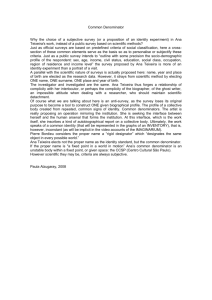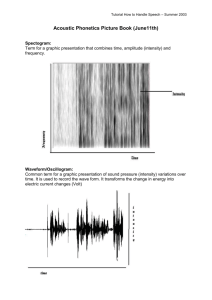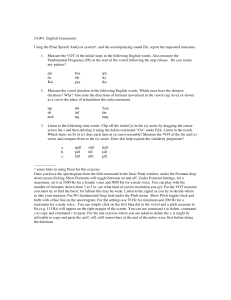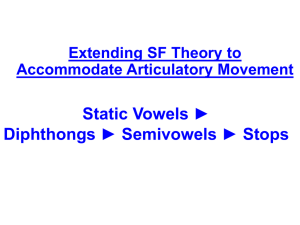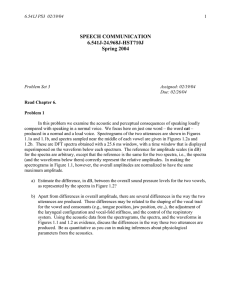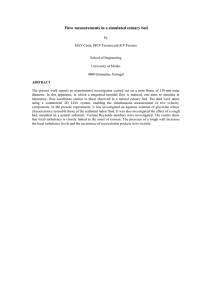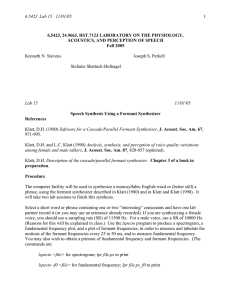Didactic speech synthesizer–acoustic module, formants model
advertisement
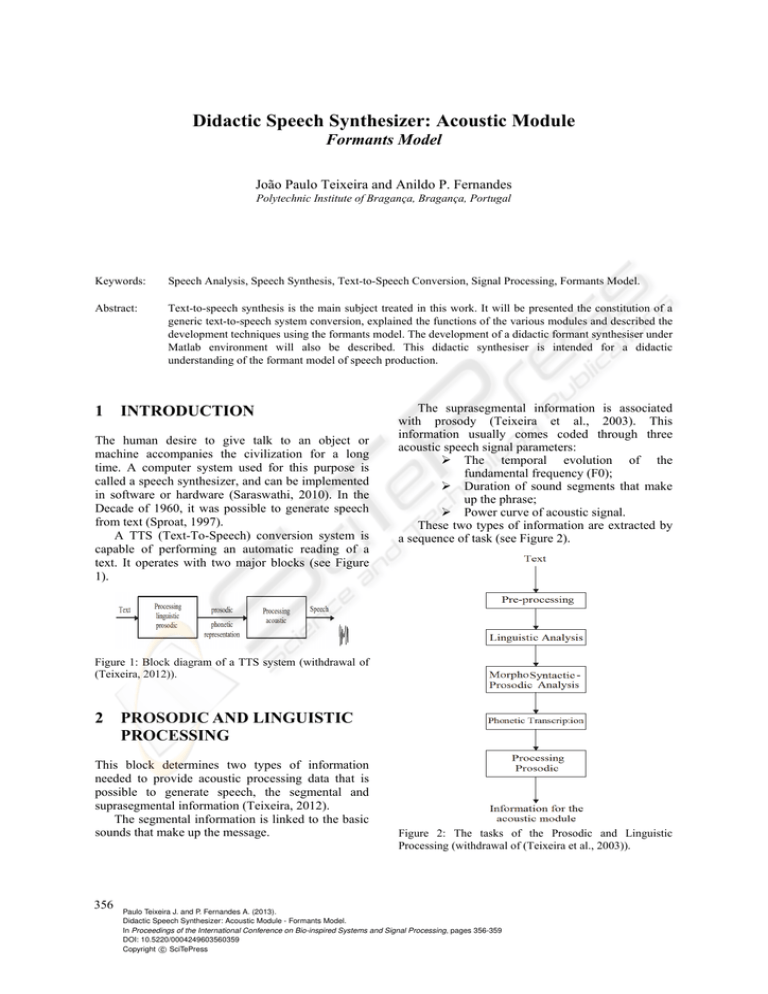
Didactic Speech Synthesizer: Acoustic Module Formants Model João Paulo Teixeira and Anildo P. Fernandes Polytechnic Institute of Bragança, Bragança, Portugal Keywords: Speech Analysis, Speech Synthesis, Text-to-Speech Conversion, Signal Processing, Formants Model. Abstract: Text-to-speech synthesis is the main subject treated in this work. It will be presented the constitution of a generic text-to-speech system conversion, explained the functions of the various modules and described the development techniques using the formants model. The development of a didactic formant synthesiser under Matlab environment will also be described. This didactic synthesiser is intended for a didactic understanding of the formant model of speech production. 1 INTRODUCTION The human desire to give talk to an object or machine accompanies the civilization for a long time. A computer system used for this purpose is called a speech synthesizer, and can be implemented in software or hardware (Saraswathi, 2010). In the Decade of 1960, it was possible to generate speech from text (Sproat, 1997). A TTS (Text-To-Speech) conversion system is capable of performing an automatic reading of a text. It operates with two major blocks (see Figure 1). The suprasegmental information is associated with prosody (Teixeira et al., 2003). This information usually comes coded through three acoustic speech signal parameters: The temporal evolution of the fundamental frequency (F0); Duration of sound segments that make up the phrase; Power curve of acoustic signal. These two types of information are extracted by a sequence of task (see Figure 2). Figure 1: Block diagram of a TTS system (withdrawal of (Teixeira, 2012)). 2 PROSODIC AND LINGUISTIC PROCESSING This block determines two types of information needed to provide acoustic processing data that is possible to generate speech, the segmental and suprasegmental information (Teixeira, 2012). The segmental information is linked to the basic sounds that make up the message. 356 Figure 2: The tasks of the Prosodic and Linguistic Processing (withdrawal of (Teixeira et al., 2003)). Paulo Teixeira J. and P. Fernandes A. (2013). Didactic Speech Synthesizer: Acoustic Module - Formants Model. In Proceedings of the International Conference on Bio-inspired Systems and Signal Processing, pages 356-359 DOI: 10.5220/0004249603560359 c SciTePress Copyright DidacticSpeechSynthesizer:AcousticModule-FormantsModel 2.1 Pre-processing 2.5.2 Modelling of Fundamental Frequency The first task of linguistic processing is the formatting of the text properly in its textual form representing numbers, abbreviations, etc (Teixeira et al., 2003). 2.2 Linguistic Analysis After pre-processing is the linguistic analysis, that includes the syntax analysis and semantic analysis (Teixeira et al., 2003). 2.3 Morpho-syntactic and Prosodic Analysis This block aims, from the previous analysis, mark the syntactic-prosodic (as the inclusion of pauses and/or enlargement of syllables) borders and the word accents (Teixeira, 95). 2.4 Phonetic Transcription Phonetic transcription is performed usually by rules. For the Portuguese language these rules are particularly complex as regards transcription of vowels, whereas, at the same natural alphabet vowel match several phonetic alphabet vowel, depending on their position in the word, accent and adjacent phonemes (Teixeira, 1995). 2.5 Modelling the fundamental frequency curves is the most important issue to convey naturalness in synthetic speech. Different type of model have been used to model the F0 parameter such as the ToBI system (Pierrehumbert, 1980), the Tilt model (Taylor, 2000), the INTSINT (INternational Transcription System for INTonation) – proposed by Hirst and Di Cristo (1998), or the Fujisaki model (Fujisaki, 1983); (Teixeira 2012), that is a parametric and deterministic model that allows the determination of the values of F0 for every instant of time. 3 ACOUSTIC PROCESSING In this block, the sequences of segments previously determined are selected from a database containing all possible segments, and concatenated successively according to each type of acoustic model. A typical block diagram for the acoustic processing is represented in the following form: (see Figure 3) Prosodic Processing Prosodic processing collects the supra-segmental and segmental information extracted from the last steps, and translates it into changes in segmental duration (rhythm), fundamental frequency (intonation) and inserting pauses with appropriate duration. 2.5.1 Modelling of Segmental Durations The term duration refers to the time it takes a certain segment of speech. The duration of the syllable can be determined by the equation (Barbosa P. and Bailly, 94): Duri exp i z i (1) Dur duration of the syllable (2) i i Where, z is the z-score of the syllable, i and i are, respectively, average and standard deviation of the logarithm of the duration of segment i. Figure 3: Block diagram of acoustic processing. There are several types of models to perform the acoustic processing. The Formant model (Klatt, DH, 1987) stores the frequency components of segments in the frequency domain (the formant frequencies and respective bandwidths). It allows a complete separation of information about source (F0) and vocal tract (formants and bandwidths). 3.1 Formant Model This type of synthesis simulates the transfer function of the vocal tract by circuit connection resonators, in series or parallel, with their respective frequencies and bandwidths used as input parameters of this synthesizer (Klatt, 1987). In figure 4 it is a schema representation of a synthesizer of formants. 357 BIOSIGNALS2013-InternationalConferenceonBio-inspiredSystemsandSignalProcessing about vocal tract namely the formats and their frequency response. Figure 4: Formants synthesis scheme (withdrawal of (Barros, 2002)). The glottal pulse model block produces a sequence of pulses spaced by the fundamental period desired. The transfer function is given by (Teixeira, 95): G( z) ae ln a z 1 1 az 1 (3) 2 a is the parameter that represents the timbre of the voice, and 0.9 is the optimal value. For unvoiced sounds excitation model is simpler. The resonances of the speech, modelled by formants, correspond to the poles of transfer function V(z). An all-pole model is a very good representation of the effects of the vocal tract for most speech sounds. The frequency response of one resonator (k) of the vocal tract can be given by (Teixeira, 95): Vk ( z ) 1 2 z 1 2 z k k cos 2 Fk T zk cos 2 Fk T z 1 zk 2 2 z 2 (4) For model the air pressure in the lips, the effects of radiation should be included. The pressure is related with the volumetric speed of the air through the lips and is modelled by a high pass filter operation. In fact at low frequencies it can be said that the pressure is derived from the volumetric velocity. The effect of radiation is expressed as (Teixeira, 95): R ( z ) R0 1 z 1 (5) 3.1.1 Development of the Didactic Synthesizer The synthesizer is developed using the graphical interface known as Guide (done in Matlab), as presented in Figure 5. It represents the information source (F0) and type of excitation signal in the upper left side, below the F1-F2 formants plane for the vowels. In the upper right side is the information 358 Figure 5: Interface to the formants model. Labels are in Portuguese. The formant and bandwidth parameters for each vowel were previously recorded. The synthesis was performed using this recorded parameters and a half Hanning windows was applied in the beginning of the speech signal and the other half Hanning window has used in the end of the speech signal in order to avoid abrupt onset and offset of speech. The vocal tract filter was implemented with the equation 4 for each formant and bandwidth. Initially the glottal function is invoked to create the glottal pulses vector. Then this signal is filtered in a cycle of 4 iterations with the correspondent frequency response filter of equation 4 and using the values of the first formant and bandwidth in the first iteration and the second, third and fourth formants/bandwidth pairs in following iterations. The result is stored into a vector for the concatenation. To implement the radiation of the lips the signal was filtered using the filter of equation 5. Then, the two half Hanning windows were applied to the beginning and end of the signal. Finally, the signal is represented in the lower window and the sound speech is reproduced. The database with the parameters of the formants and respective bandwidths for the vowels were built using the Praat program (Boersma and Weenink). To get the parameters, we have to choose the vowel and record it. Then we analyse it carefully, so we can take correct information to be used in the synthesizer (Figure 6). DidacticSpeechSynthesizer:AcousticModule-FormantsModel REFERENCES Figure 6: How to have the information of the Formants and bandwidths using Praat. 4 CONCLUSIONS AND FUTURE DEVELOPMENTS This paper described the basic mechanism of human speech production and the engineering models used to develop a TTS system. The main objectives of the blocks were explained. The acoustic module methods were also referred and a special attention was taken to the formant model because it was the model used in this development. A didactic acoustic module based in the Formant model was developed for the purpose of demonstration of the self Formant model. The application fulfils its purpose and the synthesis results with quality enough for understanding, once only a single vowel or a sequence of vowels are reproduced in this version. The application allows the synthesis of any speech sound because the user can select the vowel or the formant and bandwidth parameters. The user can also experiment different types of source excitation, from a sampled glottal wave, to a synthetic glottal wave between sinusoidal, triangular or rectangular wave formats. An evolution of this version is under development in the way of a speech synthesizer. At this moment the acoustic module is build lacking the complete development of the formant and bandwidths of diphones database. This version will allow the user to insert the phoneme sequences to be reproduced. Barbosa P., Bailly G. (1994). Characterisation of rhythmic patterns for text-to-speech synthesis, in Speech Communication, 15: 127-137. Barros, M. J., (2002). "Estudo Comparativo e Técnicas de Geração de sinal para Síntese de Fala ". Master dissertation, Faculdade de Engenharia da Universidade do Porto. Boersma, Paul and Weenink, David. Praat: doing phonetics by computer. Phonetic Sciences, University of Amsterdam. http://www.fon.hum.uva.nl/praat/ Fujisaki, H.. (1983). Dynamic characteristics of voice fundamental frequency in speech and singing. In MacNeilage. In P. F., Editor. The Production of Speech, pages 39-55. Springer-Verlag. Hirst, D. and Di Cristo, A.. (1998). Intonation Systems – A Survey of Twenty Languages. Cambridge University Press. Klatt, DH (1987). Review of text-to-speech conversion for English - Journal of the Acoustical Society of America, 82 (3) - 1987. Pages 737-793. Pierrehumbert, J. B. (1980). The Phonology and Phonetics of English Intonation. PhD thesis, Massachusetts Institute of Technology. Saraswathi, S., (2010). Design of Multilingual Speech Synthesis System. Academic journal article from Intelligent Information Management, Vol. 2, No. 1. Sproat, Richard W. (1997). Multilingual Text-to-Speech Synthesis: The Bell Labs Approach. Springer. Taylor, P. (2000). Analysis and Synthesis of Intonation using the Tilt Model. Journal of the Acoustical Society of America. vol 1073, pp. 1697-1714. Teixeira, J. P. (2012). Prosody Generation Model for TTS Systems - Segmental Durations and F0 Contours with Fujisaki Model. LAP LAMBERT Academic Publishing ISBN-13: 978-3-659-16277-0. Teixeira, J. P., (1995). "Modelização Paramétrica de Sinais para Aplicação em Sistemas de Conversão Texto-Fala." Master Dissertation, FEUP – Porto. Teixeira, J. P.,Barros, M. J. and Freitas, D., (2003). "Sistemas de Conversão Texto-Fala." Procedings of CLME, Maputo. 359
